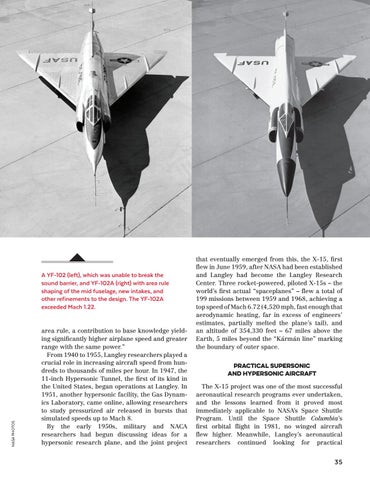NASA PHOTOS
A YF-102 (left), which was unable to break the sound barrier, and YF-102A (right) with area rule shaping of the mid fuselage, new intakes, and other refinements to the design. The YF-102A exceeded Mach 1.22. area rule, a contribution to base knowledge yielding significantly higher airplane speed and greater range with the same power.” From 1940 to 1955, Langley researchers played a crucial role in increasing aircraft speed from hundreds to thousands of miles per hour. In 1947, the 11-inch Hypersonic Tunnel, the first of its kind in the United States, began operations at Langley. In 1951, another hypersonic facility, the Gas Dynamics Laboratory, came online, allowing researchers to study pressurized air released in bursts that simulated speeds up to Mach 8. By the early 1950s, military and NACA researchers had begun discussing ideas for a hypersonic research plane, and the joint project
that eventually emerged from this, the X-15, first flew in June 1959, after NASA had been established and Langley had become the Langley Research Center. Three rocket-powered, piloted X-15s – the world’s first actual “spaceplanes” – flew a total of 199 missions between 1959 and 1968, achieving a top speed of Mach 6.72 (4,520 mph, fast enough that aerodynamic heating, far in excess of engineers’ estimates, partially melted the plane’s tail), and an altitude of 354,330 feet – 67 miles above the Earth, 5 miles beyond the “Kármán line” marking the boundary of outer space. Practical Supersonic and Hypersonic Aircraft
The X-15 project was one of the most successful aeronautical research programs ever undertaken, and the lessons learned from it proved most immediately applicable to NASA’s Space Shuttle Program. Until the Space Shuttle Columbia’s first orbital flight in 1981, no winged aircraft flew higher. Meanwhile, Langley’s aeronautical researchers continued looking for practical
35










